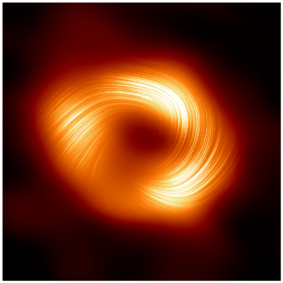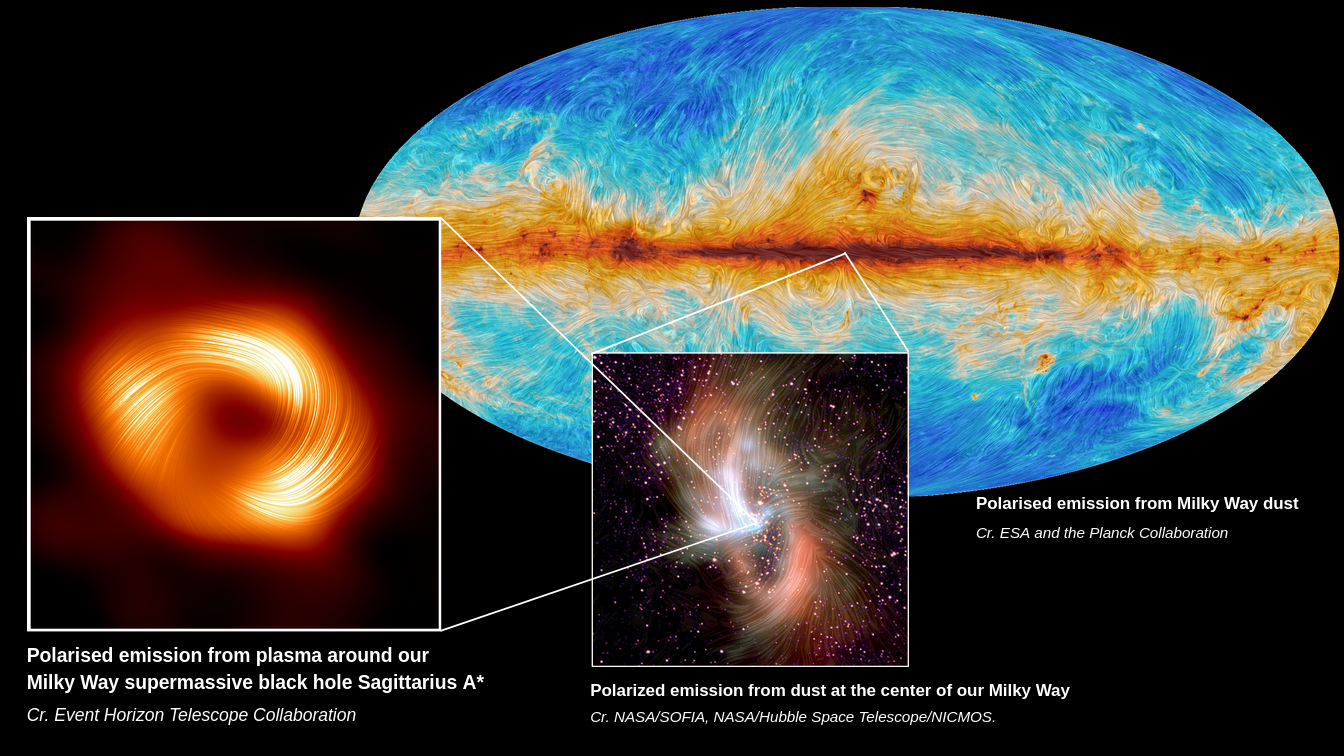
A new image from the Event Horizon Telescope (EHT) collaboration has uncovered strong and organized magnetic fields spiraling from the edge of the supermassive black hole Sagittarius A* (Sgr A*). Seen in polarized light for the first time, this new view of the monster lurking at the heart of the Milky Way Galaxy has revealed […]
A new image from the Event Horizon Telescope (EHT) collaboration has uncovered strong and organized magnetic fields spiraling from the edge of the supermassive black hole Sagittarius A* (Sgr A*). Seen in polarized light for the first time, this new view of the monster lurking at the heart of the Milky Way Galaxy has revealed a magnetic field structure strikingly similar to that of the black hole at the center of the M87 galaxy, suggesting that strong magnetic fields may be common to all black holes. This similarity also hints toward a hidden jet in Sgr A*. The results were published today in The Astrophysical Journal Letters.
Scientists unveiled the first image of Sgr A*— which is approximately 27,000 light-years away from Earth— in 2022, revealing that while the Milky Way’s supermassive black hole is more than a thousand times smaller and less massive than M87’s, it looks remarkably similar. This made scientists wonder whether the two shared common traits outside of their looks. To find out, the team decided to study Sgr A* in polarized light. Previous studies of light around M87* revealed that the magnetic fields around the black hole giant allowed it to launch powerful jets of material back into the surrounding environment. Building on this work, the new images have revealed that the same may be true for Sgr A*.
“What we’re seeing now is that there are strong, twisted, and organized magnetic fields near the black hole at the center of the Milky Way galaxy,” said Sara Issaoun, NASA Hubble Fellowship Program Einstein Fellow at the Center for Astrophysics | Harvard & Smithsonian and co-lead of the project. “Along with Sgr A* having a strikingly similar polarization structure to that seen in the much larger and more powerful M87* black hole, we’ve learned that strong and ordered magnetic fields are critical to how black holes interact with the gas and matter around them.”
Light is an oscillating, or moving, electromagnetic wave that allows us to see objects. Sometimes, light oscillates in a preferred orientation, and we call it “polarized.” Although polarized light surrounds us, to human eyes it is indistinguishable from “normal” light. In the plasma around these black holes, particles whirling around magnetic field lines impart a polarization pattern perpendicular to the field. This allows astronomers to see in increasingly vivid detail what’s happening in black hole regions and map their magnetic field lines.
“By imaging polarized light from hot glowing gas near black holes, we are directly inferring the structure and strength of the magnetic fields that thread the flow of gas and matter that the black hole feeds on and ejects,” said Harvard Black Hole Initiative Fellow and project co-lead Angelo Ricarte. “Polarized light teaches us a lot more about the astrophysics, the properties of the gas, and mechanisms that take place as a black hole feeds.”
But imaging black holes in polarized light isn’t as easy as putting on a pair of polarized sunglasses, and this is particularly true of Sgr A*, which is changing so fast that it doesn’t sit still for pictures. Imaging the supermassive black hole requires sophisticated tools above and beyond those previously used for capturing M87*, a much steadier target. EHT Project Scientist Geoffrey Bower from the Institute of Astronomy and Astrophysics, Academia Sinica, Taiwan said, “Making a polarized image is like opening the book after you have only seen the cover. Because Sgr A* moves around while we try to take its picture, it was difficult to construct even the unpolarized image,” adding that the first image was an average of multiple images due to Sgr A*’s movement. “We were relieved that polarized imaging was even possible. Some models were far too scrambled and turbulent to construct a polarized image, but nature was not so cruel.”
Scientists are excited to have images of both supermassive black holes in polarized light because these images, and the data that come with them, provide new ways to compare and contrast black holes of different sizes and masses. As technology improves, the images are likely to reveal even more secrets of black holes and their similarities or differences.
Mariafelicia De Laurentis, EHT Deputy Project Scientist and professor at the University of Naples Federico II, Italy, said, “The fact that the magnetic field structure of M87* is so similar to that of Sgr A* is significant because it suggests that the physical processes that govern how a black hole feeds and launches a jet might be universal among supermassive black holes, despite differences in mass, size, and surrounding environment. This result allows us to refine our theoretical models and simulations, improving our understanding of how matter is influenced near the event horizon of a black hole.”
The EHT has conducted several observations since 2017 and is scheduled to observe Sgr A* again in April 2024. Each year, the images improve as the EHT incorporates new telescopes, larger bandwidth, and new observing frequencies. Planned expansions for the next decade will enable high-fidelity movies of Sgr A*, may reveal a hidden jet, and could allow astronomers to observe similar polarization features in other black holes. Meanwhile, extending the EHT into space will provide sharper images of black holes than ever before.
Through the successful binational scientific and technological collaboration between Mexico and the United States, the Alfonso Serrano Large Millimeter Telescope (LMT), operated by the National Institute of Astrophysics, Optics and Electronics (INAOE) and the University of Massachusetts Amherst (UMass), with a 50 m diameter primary reflector it is the world’s largest single dish radio telescope performing observations at wavelengths in the millimeter band. The sensitivity of the GTM due to its large collecting surface at an altitude of 4600 m above sea level on the summit of the Sierra Negra volcano in the state of Puebla, combined with its geographical location at the center of the array of telescopes participating in the EHT, have represented a crucial contribution to the different observations made by this network of telescopes since 2017. The process of continuous improvements in the optimization of the LMT infrastructure and the development of new instruments will maximize Mexico’s future participation in the production of more sensitive images and movies with the EHT, and thus explore and contribute to understanding the most extreme physical conditions of the Universe around these supermassive black holes.
More Information
This research was presented in two papers by the EHT collaboration published today in The Astrophysical Journal Letters: “First Sagittarius A* Event Horizon Telescope Results. VII. Polarization of the Ring” (doi: https://doi.org/10.3847/2041-8213/ad2df0) and “First Sagittarius A* Event Horizon Telescope Results. VIII. Physical Interpretation of the Polarized Ring” (doi: https://doi.org/10.3847/2041-8213/ad2df1).
The EHT collaboration involves more than 300 researchers from Africa, Asia, Europe, and North and South America. The international collaboration is working to capture the most detailed black hole images ever obtained by creating a virtual Earth-sized telescope. Supported by considerable international investment, the EHT links existing telescopes using novel systems — creating a fundamentally new instrument with the highest angular resolving power that has yet been achieved.
The individual telescopes involved in the EHT in April 2017, when the observations were conducted, were: the Atacama Large Millimeter/submillimeter Array (ALMA), the Atacama Pathfinder EXperiment (APEX), the Institut de Radioastronomie Millimetrique (IRAM) 30-meter Telescope, the James Clerk Maxwell Telescope (JCMT), the Large Millimeter Telescope Alfonso Serrano (LMT), the Submillimeter Array (SMA), the UArizona Submillimeter Telescope (SMT), the South Pole Telescope (SPT). Since then, the EHT has added the Greenland Telescope (GLT), the IRAM NOrthern Extended Millimeter Array (NOEMA) and the UArizona 12-meter Telescope on Kitt Peak to its network.
The EHT consortium consists of 13 stakeholder institutes: the Academia Sinica Institute of Astronomy and Astrophysics, the University of Arizona, the University of Chicago, the East Asian Observatory, Goethe-Universitaet Frankfurt, Institut de Radioastronomie Millimétrique, Large Millimeter Telescope Alfonso Serrano (represented by INAOE and UMass), Max Planck Institute for Radio Astronomy, MIT Haystack Observatory, National Astronomical Observatory of Japan, Perimeter Institute for Theoretical Physics, Radboud University and the Smithsonian Astrophysical Observatory.
Contacts at INAOE
David H. Hughes
Gran Telescopio Milimétrico/INAOE
Tonantzintla, Puebla, México
Tel.: +52 222 266 31 00
Email: dhughes@inaoep.mx
Alfredo Montaña
Gran Telescopio Milimétrico/INAOE
Tonantzintla, Puebla, México
Tel.: +52 222 266 31 00
Email: amontana@inaoep.mx
Arturo Gómez Ruiz
Gran Telescopio Milimétrico/INAOE
Tonantzintla, Puebla, México
Tel: +52 222 266 31 00
Email: aigomez@inaoep.mx
David Sánchez Argüelles
Gran Telescopio Milimétrico/INAOE
Tonantzintla, Puebla, México
Tel: +52 222 266 31 00
Email: domars@inaoep.mx
EHT researchers in this press release
Sara Issaoun
Center for Astrophysics | Harvard & Smithsonian, USA
Email: sara.issaoun@cfa.harvard.edu
Angelo Ricarte
Center for Astrophysics | Harvard & Smithsonian, USA
Email: angelo.ricarte@cfa.harvard.edu
Geoffrey Bower
EHT Project Scientist
Institute of Astronomy and Astrophysics, Academic Sinica, Taiwan
Email: gbower@asiaa.sinica.edu.tw
Mariafelicia De Laurentis
EHT Deputy Project Scientist
University of Naples Federico II, Italy
Email: mariafelicia.delaurentis@unina.it

A view of the Milky Way supermassive black hole Sagittarius A* in polarized light.
The Event Horizon Telescope (EHT) collaboration, who produced the first ever image of our Milky Way black hole released in 2022, has captured a new view of the massive object at the center of our Galaxy: how it looks in polarized light. This is the first time astronomers have been able to measure polarization, a signature of magnetic fields, this close to the edge of Sagittarius A*. This image shows the polarized view of the Milky Way black hole. The lines mark the orientation of polarization, which is related to the magnetic field around the shadow of the black hole.
Credit: EHT Collaboration

The Polarized Milky Way in Multiple Wavelengths.
At left, the supermassive black hole at the center of the Milky Way Galaxy, Sagittarius A*, is seen in polarized light, the visible lines indicating the orientation of polarization, which is related to the magnetic field around the shadow of the black hole. At center, the polarized emission from the center of the Milky Way, as captured by SOFIA. At back right, the Planck Collaboration mapped polarized emission from dust across the Milky Way.
Credits: Left: EHT Collaboration, Center: NASA/SOFIA, NASA/HST/NICMOS, Back right: ESA/Planck Collaboration

M87* and Sgr A* Side-by-Side in Polarized Light.
Seen here in polarized light, this side-by-side image of the supermassive black holes M87* and Sagittarius A* indicates to scientists that these beasts have similar magnetic field structures. This is significant because it suggests that the physical processes that govern how a black hole feeds and launches a jet may be universal features amongst supermassive black holes.
Credit: EHT Collaboration